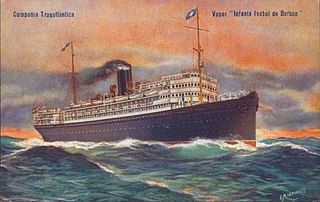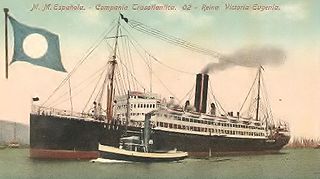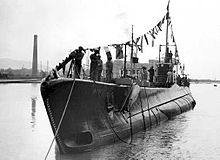
MS St. Louis was a diesel-powered passenger ship properly referred to with the prefix MS or MV, built by the Bremer Vulkan shipyards in Bremen for HAPAG, better known in English as the Hamburg America Line. The ship was named after the city of St. Louis, Missouri. Her sister ship, MS Milwaukee, was also a diesel powered motor vessel owned by the Hamburg America Line. St. Louis regularly sailed the trans-Atlantic route from Hamburg to Halifax, Nova Scotia, and New York City, and made cruises to the Canary Islands, Madeira, Spain; and Morocco. St. Louis was built for both transatlantic liner service and for leisure cruises.
SS A. Mitchell Palmer (MCE-2436) was an EC2-S-C1 Type Liberty ship design cargo ship, named after U.S. Attorney General Alexander Mitchell Palmer. The ship's keel was laid by Southeastern Shipbuilding Corporation of Savannah, Georgia, on 17 December 1943, commissioned as part of the Second World War effort by the War Shipping Administration (WSA). It was launched 12 February 1944. It was scrapped in 1968 in Taiwan.
The Struma disaster was the sinking on 24 February 1942 of a ship, MV Struma, which had been trying to take nearly 800 Jewish refugees from the Axis member Romania to Mandatory Palestine. She was a small iron-hulled ship of only 240 GRT and had been built in 1867 as a steam-powered schooner but had recently been re-engined with an unreliable second-hand diesel engine. Struma was only 148.4 ft (45 m) long, had a beam of only 19.3 ft (6 m) and a draught of only 9.9 ft (3 m) but an estimated 781 refugees and 10 crew were crammed into her.

The SS Mongolia was a steam turbine-driven twin-screw passenger-and-cargo ocean liner launched in 1922 for the Peninsular and Oriental Steam Navigation Company (P&O) for service from the United Kingdom to Australia. Later in P&O service she sailed for New Zealand, and in 1938 she was chartered to a P&O subsidiary, the New Zealand Shipping Company, as SS Rimutaka.

SS Manhattan was a 24,189 GRT luxury ocean liner of the United States Lines, named after the Manhattan borough of New York City. On 15 June 1941 she was commissioned as USS Wakefield and became the largest ship ever operated by the US Coast Guard. In 1942 she caught fire and was rebuilt as a troop ship. Manhattan never saw commercial service again.

Barbarigo was a World War II Italian Marcello-class submarine. It was built by the Cantieri Riuniti dell'Adriatico, and was commissioned on 19 September 1938.
SS Marine Marlin was a type C4-S-A3 ship built in 1945 by Kaiser Shipyards, Vancouver, Washington, as a troop transport ship. She had a capacity to carry 3,485 troops and was built for operation by the War Shipping Administration. The ship's first voyage from Portland, Oregon on 5 December 1945 to Yokohama, Japan was followed by a shift to the Atlantic arriving at New York on 26 February 1946. From then the ship operated as a transport to Puerto Rico and Jamaica to New York and Charleston.

Compañía Transatlántica Española, S.A., also known as the Spanish Line in English, was a passenger ocean line that has largely ceased operations although it still exists as a company. It is popularly known as "La Trasatlántica" in the Spanish language.

Nicolás Mihanovich (1846–1929) was a Croatian Argentine businessman closely linked to the development of the Argentine merchant marine.

Empresa Líneas Marítimas Argentinas (ELMA) was an Argentine cargo shipping line formed on September 30, 1960, after Juan Perón nationalised the shipping industry. The Argentine Maritime Lines Company involved the merger of two companies, both state: the Merchant Fleet of the State (FME) and Argentina Fleet of Navigation of Ultramar (FANU). It served Argentina's foreign trade until the 1990s, when the government of Carlos Menem declared its dissolution. At its peak its fleet had more than 60 ships. Ships sailed to Northern Europe, the United Kingdom, the Baltic Sea, the Mediterranean, the east coasts of the United States of America and Canada, the Gulf of Mexico, the Pacific, the Middle East and Far East and Africa.

RMS Ebro was an ocean liner built in 1914 for the Royal Mail Steam Packet Company. She was later owned and operated by the Pacific Steam Navigation Company, Jugoslavenska Lloyd and finally by Companhia Colonial de Navegação. In her last incarnation, under the name Serpa Pinto, she made more crossings of the Atlantic during the Second World War than any other civilian vessel, leading to her being termed the Friendship vessel or Destiny ship. She was scrapped in 1954.
SS Quanza was a World War II-era Portuguese passenger-cargo ship, best known for carrying 317 people, many of them refugees, from Nazi-occupied Europe to North America in 1940. At least 100 of its passengers were Jewish.

MV Struma was a small ship with a long history that included a number of changes of use and many changes of name. She was built in 1867 as a British marquess's luxury steam yacht and ended up 75 years later as a Greek and Bulgarian diesel ship for carrying livestock. She was launched as Xantha, but subsequently carried the names Sölyst, Sea Maid, Kafireus, Esperos, Makedoniya and finally Struma.

SS Gustavus Victory was constructed in Bethlehem-Fairfield Shipyard in Baltimore, Maryland. The 75th Victory ship, it was named for Gustavus Adolphus College in Saint Peter, Minnesota, which was named for the 17th century King of Sweden Gustav II Adolf. The college made a gift towards furnishing a ship library, which comprised two 40-book units and was managed by the American Merchant Marine Library Association.
Anselm was a cargo and passenger steamship built by Workman, Clark and Company in Belfast for the Booth Line service between Liverpool and the Amazon ports in Brazil. She was the second of four Booth Line ships to be named after Saint Anselm.

SS Infanta Isabel de Borbon was a steam ocean liner and mail ship launched in 1912 in Scotland and operated by the Compañía Transatlántica Española (CTE). She and her sister ship Reina Victoria-Eugenia represented a significant modernisation of CTE's fleet of ageing and obsolescent ships.

SS Reina Victoria-Eugenia was a steam ocean liner and mail ship launched in 1912 in England and operated by the Compañía Transatlántica Española (CTE). She and her sister ship Infanta Isabel de Borbon represented a significant modernisation of CTE's fleet of ageing and obsolescent ships.

Cabo Machichaco was an iron-hulled cargo steamship that was built in England in 1882 as Benisaf, and renamed Cabo Machichaco in 1886. She was destroyed by two explosions in her cargo in 1893 and 1894 in the port of Santander, Spain. The first explosion killed several hundred people in the city of Santander as well as on the ship, and was Spain's worst peacetime disaster in the 19th century. The second explosion killed a number of workers who were salving the remainder of her cargo from her sunken wreck.
SSVizcaya (ex-Chusan) was a steel-hulled, steam freighter that operated in the Commonwealth of the Philippines. She was scuttled at Manila in December 1941.













